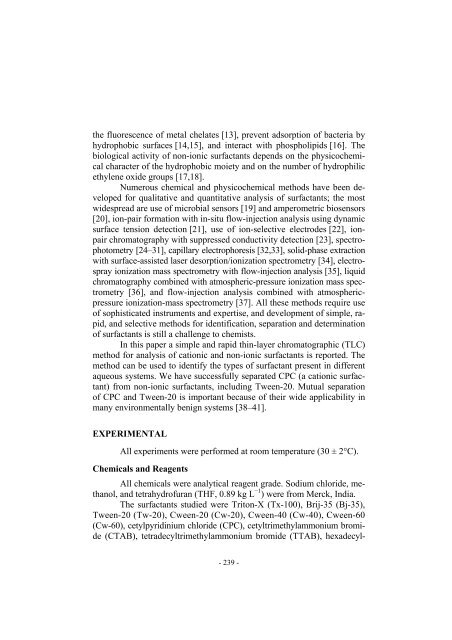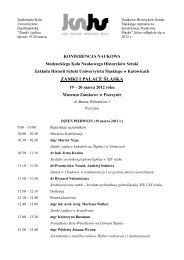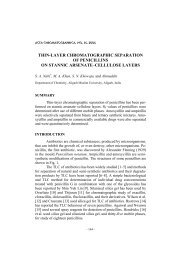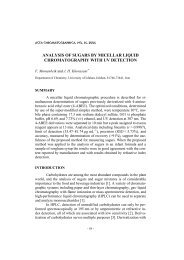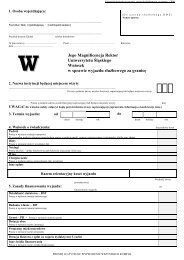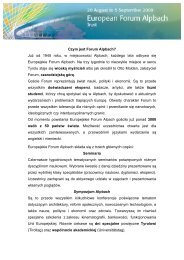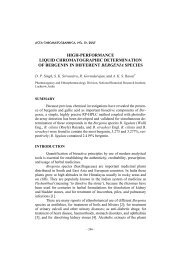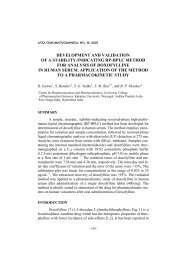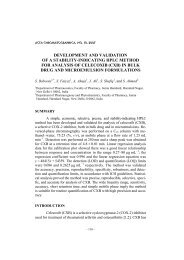Silica thin layer chromatographic separation of cetylpyridinium ...
Silica thin layer chromatographic separation of cetylpyridinium ...
Silica thin layer chromatographic separation of cetylpyridinium ...
Create successful ePaper yourself
Turn your PDF publications into a flip-book with our unique Google optimized e-Paper software.
the fluorescence <strong>of</strong> metal chelates [13], prevent adsorption <strong>of</strong> bacteria by<br />
hydrophobic surfaces [14,15], and interact with phospholipids [16]. The<br />
biological activity <strong>of</strong> non-ionic surfactants depends on the physicochemical<br />
character <strong>of</strong> the hydrophobic moiety and on the number <strong>of</strong> hydrophilic<br />
ethylene oxide groups [17,18].<br />
Numerous chemical and physicochemical methods have been developed<br />
for qualitative and quantitative analysis <strong>of</strong> surfactants; the most<br />
widespread are use <strong>of</strong> microbial sensors [19] and amperometric biosensors<br />
[20], ion-pair formation with in-situ flow-injection analysis using dynamic<br />
surface tension detection [21], use <strong>of</strong> ion-selective electrodes [22], ionpair<br />
chromatography with suppressed conductivity detection [23], spectrophotometry<br />
[24–31], capillary electrophoresis [32,33], solid-phase extraction<br />
with surface-assisted laser desorption/ionization spectrometry [34], electrospray<br />
ionization mass spectrometry with flow-injection analysis [35], liquid<br />
chromatography combined with atmospheric-pressure ionization mass spectrometry<br />
[36], and flow-injection analysis combined with atmosphericpressure<br />
ionization-mass spectrometry [37]. All these methods require use<br />
<strong>of</strong> sophisticated instruments and expertise, and development <strong>of</strong> simple, rapid,<br />
and selective methods for identification, <strong>separation</strong> and determination<br />
<strong>of</strong> surfactants is still a challenge to chemists.<br />
In this paper a simple and rapid <strong>thin</strong>-<strong>layer</strong> <strong>chromatographic</strong> (TLC)<br />
method for analysis <strong>of</strong> cationic and non-ionic surfactants is reported. The<br />
method can be used to identify the types <strong>of</strong> surfactant present in different<br />
aqueous systems. We have successfully separated CPC (a cationic surfactant)<br />
from non-ionic surfactants, including Tween-20. Mutual <strong>separation</strong><br />
<strong>of</strong> CPC and Tween-20 is important because <strong>of</strong> their wide applicability in<br />
many environmentally benign systems [38–41].<br />
EXPERIMENTAL<br />
All experiments were performed at room temperature (30 ± 2°C).<br />
Chemicals and Reagents<br />
All chemicals were analytical reagent grade. Sodium chloride, methanol,<br />
and tetrahydr<strong>of</strong>uran (THF, 0.89 kg L −1 ) were from Merck, India.<br />
The surfactants studied were Triton-X (Tx-100), Brij-35 (Bj-35),<br />
Tween-20 (Tw-20), Cween-20 (Cw-20), Cween-40 (Cw-40), Cween-60<br />
(Cw-60), <strong>cetylpyridinium</strong> chloride (CPC), cetyltrimethylammonium bromide<br />
(CTAB), tetradecyltrimethylammonium bromide (TTAB), hexadecyl-<br />
- 239 -


